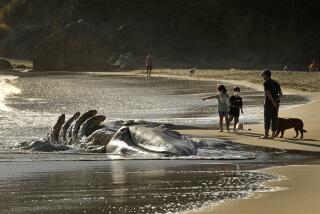Gray Whales’ Numbers Rebound
PIEDRAS BLANCAS, Calif. — Federal biologists here have reported the highest count of migrating gray whale calves in 11 years, an encouraging sign for a species that had appeared to be in decline recently.
Conducting the annual March to June survey as the whales swim north, biologists with the National Oceanic and Atmospheric Administration counted 455 pairs of calves and mothers from a vantage point along the coast in northern San Luis Obispo County.
The counts had been as low as 97 calves in 2000 and 87 in 2001.
The scientists estimate that if they had been working during daylight six days a week, as in past years, the tally would have been 550 calves, the most ever. For budgetary reasons, this year they worked five 12-hour days a week.
“We expected a significant jump,” said federal marine biologist Wayne Perryman. “But this exceeded what I could have predicted.”
The new numbers bolster the growing scientific belief that the gray whale population -- and successful calving in particular -- is dependent on an early ice melt in the Bering Strait and Chukchi Sea, in the Arctic Ocean. It is in those feeding grounds that gray whales consume 95% of their diet, dragging their mouths on the muddy bottom and using their baleen to filter out the small crustaceans they consume by the tons.
Perryman said the ice melt theory is becoming more widely accepted among researchers. Before each of the dismal years of 1999, 2000 and 2001, ice covering the ocean stayed frozen in wide expanses of some of the best feeding grounds in the Arctic. Last year, the ice melted early, affording the whales more feeding time.
The whales are believed to subsist on fat reserves for much of the year: during their southward migration, their winter respite in lagoons along the southern Baja coastline, and their return northward migration. The experience can be particularly taxing for females that give birth either on the southbound migration or in the lagoons and nurse their young before returning to the Arctic feeding grounds, Perryman said.
Perryman estimated that the population of gray whales, removed from the federal endangered species list in 1994, has surpassed 20,000. The count of the southward migration totaled 27,958 in 1998, but it dropped to 16,848 in 2002, the last year the whales were counted. Around 1900, their numbers had dropped as low as 1,000.
Federal scientists have no immediate plans for another official southbound census, and the annual tally of northbound calves at Piedras Blancas is not recognized as the official count of the entire gray whale population.
But Perryman wonders whether the last official census was skewed because some whales may have forgone the long trip south to remain in the Arctic to feed.
“It may be that in bad years, not everybody migrates,” Perryman said. “Who wants to go to Club Med to mate when you’re hungry?”
Gray whales follow a certain routine, he said. In the fall after the calves are weaned, they all go in one giant southbound migration. But the northbound migration is more nuanced.
The first migration north is a large “pulse” of non-nursing adults and juveniles, ending in late February, and it is believed that most of them swim one or two miles offshore. It is these whales that are the focus of most whale-watching expeditions.
A much smaller migration of females and their young leaves later, when the newest calves, still nursing, are bigger. These pairs hug the shore. Biologists believe they do so to protect the young from killer whales that lurk in broad, deep expanses of water, such as Monterey Bay.
The youngsters are then weaned in the northern waters.
“There are a bunch of things we still don’t know,” Perryman said. “We continue to watch this population carefully. There’s the whole question of what will happen with the ice again.
“Once you get to the Bering Strait and the Chukchi Sea, the weather is so unpredictable.”
More to Read
Sign up for Essential California
The most important California stories and recommendations in your inbox every morning.
You may occasionally receive promotional content from the Los Angeles Times.










